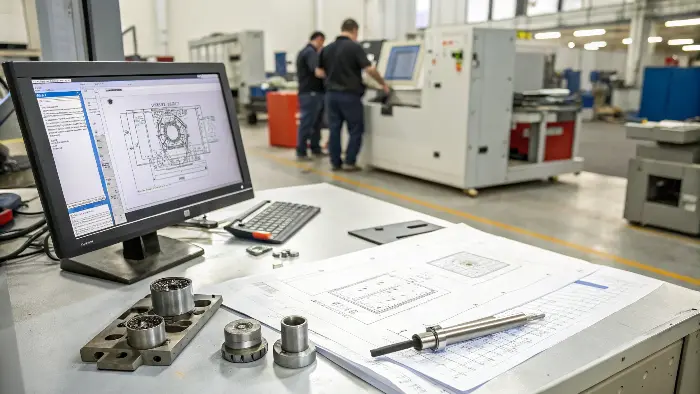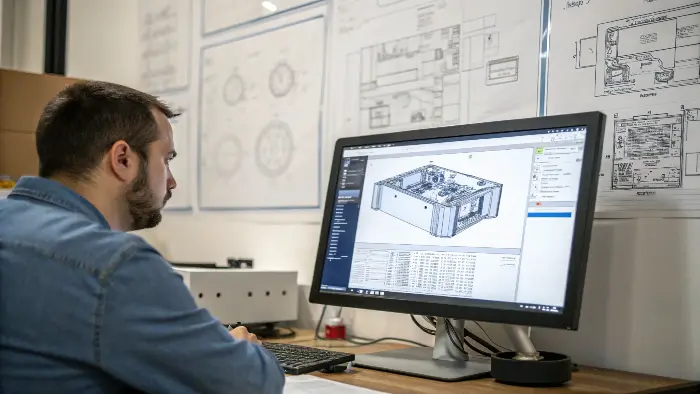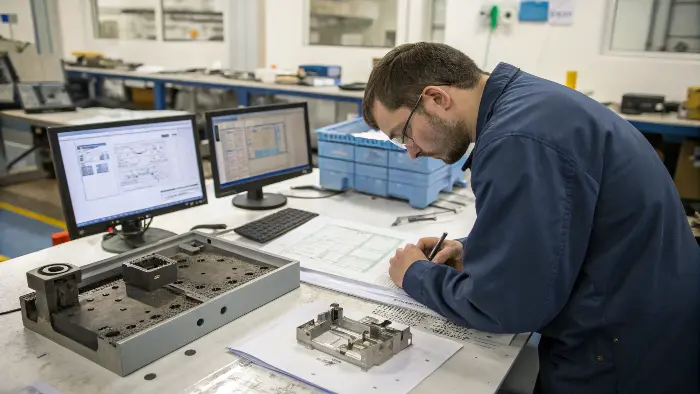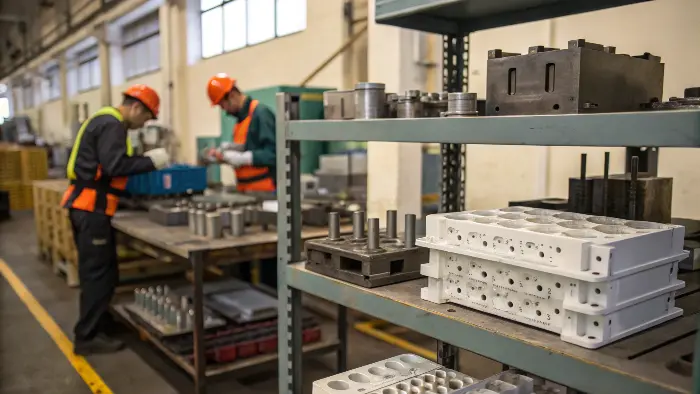Are you aiming for a career as a top-tier mold designer but feel lost about where to start? The path can seem confusing, requiring a specific blend of technical knowledge and real-world experience. Without a clear guide, you risk spending time on the wrong skills, falling behind in an industry where precision is everything. I’ll show you the essential steps to become a successful mold designer.
To become a successful mold designer, you generally need an associate’s degree in plastics engineering or a related technology field, plus five to eight years of direct industry experience. Crucially, you must develop excellent problem-solving skills, master CAD software, and gain a deep understanding of the entire manufacturing process. This combination of formal education and hands-on application is the foundation for designing effective, high-quality molds that meet both client and production demands.

So, you have the basic requirements, but what does the journey actually look like? It’s about more than just a degree and years on a resume. It’s about developing a specific mindset and a deep understanding of how a simple idea becomes a physical product millions of times over.
Let’s dive deeper into the specific roles, skills, and even the costs involved in this profession. Understanding these details will give you a real-world advantage and a clear map to follow on your path to success in the mold manufacturing industry.
What is a Mould designer?
You often hear the term "mold designer," but what does that title really mean? It sounds highly technical and specific, maybe even a little mysterious if you’re outside the industry. This lack of clarity can be a barrier when you’re trying to figure out if this is the right career for you. Let me clarify exactly what a mold designer is: a critical link between a product idea and its physical creation.
A mold designer is a specialized engineer who creates the detailed blueprints for molds, which are primarily used in plastic injection molding. Using CAD software, they design every component, from the mold’s core and cavity to its runners and cooling systems. Their work ensures a product can be manufactured efficiently, accurately, and with high quality, balancing technical requirements with production costs and material properties.

A mold designer is much more than just a drafter who draws parts on a computer. They are a unique blend of engineer, artist, and problem-solver. The role requires an immense amount of technical precision, but it also demands creativity to overcome design challenges. You have to visualize how molten plastic will behave under immense pressure, how a part will cool and shrink, and how it can be ejected from the mold perfectly every single time. This requires a deep, practical understanding of physics, materials science, and the entire manufacturing workflow. I’ve found that the best designers have an intuitive feel for how a mold will perform even before the first piece of steel is cut.
The Designer’s Core Responsibilities
The role is multifaceted, touching every stage of the mold-making process. It’s a position of great responsibility because the quality of the mold design directly impacts the quality of the final product and the profitability of the production run. Here are some of the key responsibilities that define the job:
| Responsibility | Description |
|---|---|
| CAD Modeling | Creating highly detailed 3D models and 2D technical drawings of the entire mold assembly. |
| Material Selection | Advising the client on the best plastic resin for the part and the right type of steel for the mold. |
| Mold Flow Analysis | Using simulation software to predict how the plastic will fill the mold to prevent defects. |
| Collaboration | Working closely with product designers, toolmakers, and project managers to ensure alignment. |
| Troubleshooting | Identifying and solving design-related issues that arise during mold trials and mass production. |
Collaboration is a huge part of my job. I regularly work with project managers like Alex, who depend on my expertise to confirm that a mold design is not only technically sound but also feasible within the project’s timeline and budget. The designer acts as a central hub, translating the client’s vision into a practical, functional tool that the team on the shop floor can build and operate efficiently.
What do mold designers do?
Knowing the definition of a mold designer is one thing, but what does a typical day or project actually involve? It’s easy to picture someone just sitting at a computer screen all day long. That picture is incomplete and doesn’t capture the dynamic problem-solving and collaboration that make the role so engaging. Let’s walk through the daily tasks and responsibilities that truly define the work of a professional mold designer.
A mold designer’s daily work involves translating a product concept into a functional mold. This includes creating detailed 3D CAD models, running mold flow analysis to optimize the injection process, and selecting the right materials. They constantly collaborate with engineers and clients to refine designs, troubleshoot potential manufacturing issues, and ensure the final mold is efficient, durable, and produces perfect parts.

The entire process is a structured journey from a digital file to a physical, steel tool. It’s a job that requires you to think several steps ahead at all times, anticipating problems before they happen.
From Product Part to Mold Blueprint
The journey always begins with the customer’s 3D part file. The very first thing I do is a comprehensive Design for Manufacturability (DFM) analysis. This is a critical review where I examine the part design for any features that could cause problems during molding. I look for things like undercuts that would trap the part in the mold, sharp internal corners that create stress points, or inconsistent wall thicknesses that can lead to sink marks and warpage. I then create a detailed report with my suggestions and discuss it with the client. This initial step is probably the most valuable service I provide, as it can save enormous amounts of time and money later on.
The Core Design Workflow
Once the part design is approved, I begin designing the mold itself. This is a systematic process of building the mold layer by layer in the CAD software. It involves designing several key systems that must work together perfectly.
| Stage | Key Activities | Tools Used |
|---|---|---|
| 1. Initial Review | DFM analysis, client consultation, feasibility study. | CAD Software (e.g., SolidWorks, UG/NX), Communication Tools |
| 2. Preliminary Design | 3D mold layout, core and cavity block design, parting line definition. | CAD Software |
| 3. Detailed Design | Designing runner systems, cooling channels, and ejection mechanisms. | Mold Flow Analysis Software, CAD Software |
| 4. Finalization | Creating 2D manufacturing drawings, Bill of Materials (BOM), and assembly instructions. | CAD Software, ERP Systems |
I remember one project for a thin-walled electronics housing. The initial design had a high risk of warpage. By running a mold flow simulation, I was able to show the client exactly how the part would deform after cooling. We then worked together to add a few subtle ribs to the design and optimized the gate location. The result? The first trial parts came out perfectly straight. That’s where a designer’s expertise really shines—in preventing problems, not just fixing them.
What things could you do to improve mold design?
You’ve designed a mold that works, but is it the best it can be? It’s very easy to fall into a routine, sticking with familiar techniques and producing designs that are functional but not fully optimized. This complacency can lead to longer cycle times, higher part defect rates, and increased costs for your client, which ultimately hurts your reputation. Let me share some key strategies you can use to elevate your mold designs.
To improve mold design, start with a rigorous Design for Manufacturability (DFM) analysis. Focus heavily on optimizing the cooling system, as this governs cycle time and part quality. Use mold flow simulation software to predict and solve problems before cutting steel. Also, simplify the mold structure wherever possible to reduce complexity and cost, and always maintain close collaboration with the toolmaker for practical feedback.

Moving from a good designer to a great one is about a commitment to continuous improvement and a willingness to embrace new technologies and techniques. It’s about designing for performance, not just for function.
Master the Art of Cooling
Cooling is often the most underestimated aspect of mold design, yet it is arguably the most critical factor for an efficient injection molding process. The cooling phase can account for over 70% of the total cycle time. Therefore, any improvement in cooling efficiency directly translates into significant cost savings for the client. One of the most impactful advancements in this area is conformal cooling. Unlike traditional cooling channels, which are straight lines drilled into the mold, conformal channels follow the contours of the part. This provides much more uniform cooling, which drastically reduces warpage and can slash cycle times. While it’s more complex to design, the return on investment is huge.
Embrace Simulation and Analysis
In modern mold design, there’s no room for guesswork. Mold flow analysis software is an absolutely essential tool. It allows you to simulate the entire injection molding process digitally, helping you visualize and solve problems before they ever become physical realities. You can see exactly how the plastic will fill the cavity, identify where weld lines and air traps will form, and accurately predict how the part will warp as it cools.
| Feature | Traditional Approach | Optimized Approach |
|---|---|---|
| Cooling | Standard straight-drilled channels. | Conformal cooling, layout optimized with thermal analysis. |
| Gating | Placed for easy machining or based on old rules. | Placed based on flow simulation for the best fill pattern and pressure. |
| Venting | Using standard vent depths and locations. | Calculating precise vent sizes and locations based on fill simulation. |
| Feedback | Waiting for problems to appear during the mold trial. | Proactively solving issues with DFM and flow analysis reports. |
Early in my career, I designed a mold for a large, flat lid. The first trial parts came out warped like a potato chip. We spent days trying to fix it by adjusting machine parameters. If I had run a proper warpage analysis back then, I would have immediately seen that the gate location was causing uneven shrinkage. A simple design change would have saved the project from weeks of costly delays and frustration. That lesson stuck with me. Now, simulation is a non-negotiable step in my process.
How much does it cost to create a mold?
You have a great idea for a new product, but the potential cost of the injection mold is a huge unknown. It’s a major capital investment, and you’re rightly concerned about getting an unexpected, budget-breaking bill. Without a clear understanding of the factors that drive mold costs, you can’t budget effectively or make informed decisions, potentially leading to project delays or compromises on quality. Let’s demystify mold costs.
The cost to create a mold can range from a few thousand dollars to well over a hundred thousand. The final price depends on the part’s size and complexity, the type of steel used for the mold, the number of cavities, and the required production lifespan. A simple, single-cavity prototype mold in aluminum will be far cheaper than a complex, multi-cavity production mold made from hardened tool steel.

As a mold designer, part of my job is to design a tool that not only produces a great part but also aligns with the client’s budget and production goals. Understanding the cost structure is essential for this.
The Core Cost Factors
The price of a mold is not arbitrary. It’s a direct calculation based on several tangible factors. A good designer knows how to manipulate these factors to deliver a cost-effective solution without sacrificing quality. The main drivers are:
- Part Complexity: The more intricate the part, the more complex the mold. Features like undercuts, threads, tight tolerances, and fine surface textures require more sophisticated and time-consuming machining processes like EDM (Electrical Discharge Machining) and additional mechanisms like side-actions or lifters, all of which add to the cost.
- Mold Material: The choice of steel is critical. For low-volume prototyping, a softer material like Aluminum 7075 can be used, which is cheaper and faster to machine. For high-volume production, you need durable, hardened tool steels like P20, NAK80, or H13. These materials are more expensive and harder to machine, but they can last for a million cycles or more.
- Number of Cavities: A single-cavity mold produces one part per cycle. A multi-cavity mold (with 2, 4, 8, or even 64 cavities) produces multiple parts per cycle. This drastically lowers the cost per part but significantly increases the upfront cost and complexity of the mold itself.
A Breakdown of Cost Components
To give you a clearer picture, here’s a rough breakdown of where the money goes when you buy a mold:
| Cost Component | Percentage of Total (Approx.) | Description |
|---|---|---|
| Mold Base & Steel | 20-30% | The cost of the raw materials for the mold’s frame and the core/cavity inserts. |
| Machining (CNC, EDM) | 40-50% | This is the biggest cost, representing the machine time and labor to cut the steel into the final shape. |
| Design & Engineering | 10-15% | The time spent by the mold designer on DFM, CAD modeling, simulation, and creating drawings. |
| Assembly & Polishing | 10-15% | The skilled labor required to fit all components, polish surfaces, and test the mold. |
My role as a designer is to find the sweet spot. For a client like Alex, who needs high-precision parts for consumer electronics, we can’t compromise on quality. However, I can often suggest a minor tweak to a part design that eliminates the need for a costly lifter mechanism, or I can design the mold components for more efficient machining. It’s about achieving the client’s goals through smart, cost-conscious design.
Conclusion
Becoming a successful mold designer is a journey of continuous learning and dedication. It requires a solid educational foundation, years of hands-on experience, and a commitment to mastering essential tools like CAD and simulation software. By focusing on collaboration, designing for manufacturability, and understanding the business impact of your designs, you can build a rewarding and vital career in this fascinating industry.
